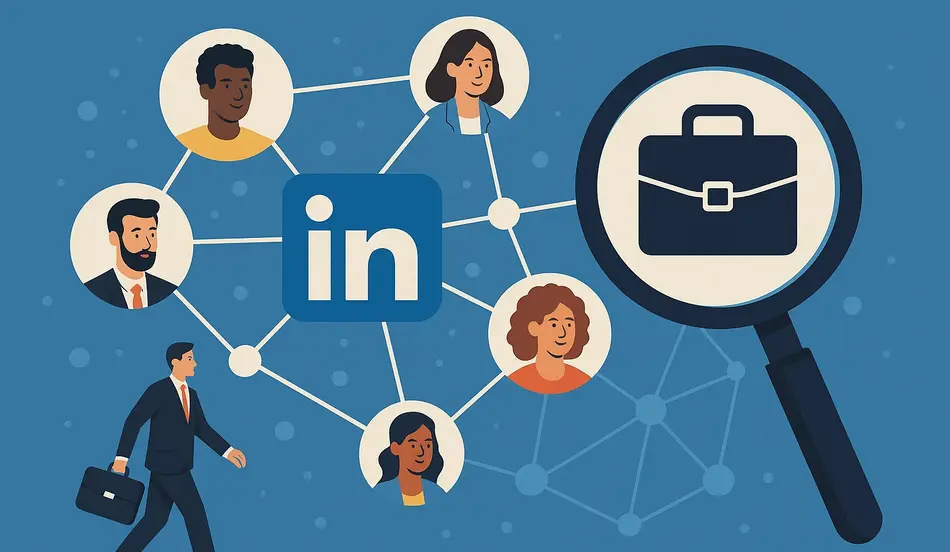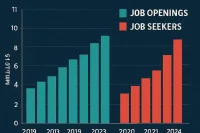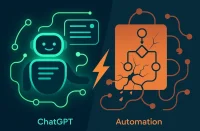Is LinkedIn destroying the job market? The harsh reality
Is LinkedIn destroying the job market? While widely regarded as the premier networking platform, LinkedIn has fundamentally changed how careers work—and not always for the better. With 87% of recruiters using LinkedIn to find talent, the platform holds near-monopoly power over professional networking. But this dominance comes with a cost: paywalls, fake content, predatory job postings, and a two-tier system that disadvantages job seekers who can’t afford premium access. The platform that was supposed to democratize job searching has become a gatekeeper that’s slowly ruining careers as we know them.
How we got here: from newspaper ads to LinkedIn monopoly
The evolution of job searching
Before the internet, job seekers relied on newspaper classifieds, walking into company headquarters, word of mouth, or mailing resumes to headhunters. The shift began with the Online Career Center (OCC) in 1993, followed by Monster.com in 1994 and CareerBuilder in 1995. These platforms digitized job searching and shrank the gap between candidates and employers, laying the groundwork for what would become LinkedIn’s dominance.
LinkedIn’s game-changing approach
LinkedIn launched in 2003 but revolutionized hiring after 2008 when it introduced company pages and job postings. Unlike traditional job boards, LinkedIn combined professional networking with job search, creating a dynamic ecosystem. By 2010, LinkedIn Recruiter became the go-to tool for talent acquisition, shifting hiring from passive job listings to active talent sourcing—where recruiters find candidates rather than waiting for applications.
The first major problem: active sourcing vs active applying
Why most job seekers are invisible
Most people still use active applying—submitting applications to posted jobs—while companies overwhelmingly rely on active talent sourcing. If you’re not being recruited for a position, you almost have no chance at getting an interview. This fundamental mismatch means qualified candidates are invisible to employers who prefer to find people rather than review applications.
The Easy Apply problem
LinkedIn’s Easy Apply feature, introduced in 2011, streamlined applications to a single click, but this created an avalanche of unqualified candidates. Recruiters are buried with thousands of applications for every role, most from people who aren’t even based in the United States or remotely qualified. Getting seen has become increasingly difficult as the signal-to-noise ratio plummets.
The networking and branding requirement
Why you must market yourself
Hiring now emphasizes networking and personal branding, requiring job seekers to adapt out of necessity rather than desire. Many people are nauseated by the idea of marketing themselves to employers through networking and branding—they see it as unsavory ass-kissing that shouldn’t be necessary for career success. However, with 87% of recruiters using LinkedIn, this shift has become unavoidable.
The algorithm problem
LinkedIn’s algorithms prioritize viral, emotionally charged content—generic inspirational stories, humble brags, and one-size-fits-all advice. Meanwhile, thoughtful, nuanced, critical voices are often drowned out. When you post something generic and high-level, you get engagement. When you post valuable, step-by-step guidance, you get crickets. This makes it increasingly difficult for real professionals to stand out and build genuine credibility.
LinkedIn’s near-monopoly and paywall problem
The two-tier system
If you’re not on LinkedIn, you’re virtually invisible to most recruiters and employers. But as LinkedIn’s dominance has grown, so have its paywalls. Features that were once free—seeing who viewed your profile, sending direct messages, custom connection request messages, unlimited search—are now locked behind expensive subscriptions. This creates a two-tier system where those who can pay for premium access have advantages over those who can’t.
Disadvantaging the unemployed
If you’re out of work or just starting out, you’re at a significant disadvantage. Premium LinkedIn subscriptions can cost hundreds of dollars annually, making job search even more challenging for those who need opportunities most. This paywall system perpetuates inequality in the job market.
Predatory practices and fake content
Unpaid opportunities for experienced professionals
LinkedIn is rife with companies offering unpaid opportunities to experienced professionals, sometimes disguising them as internships or portfolio projects. These “evergreen posts” have no intention of hiring anyone—they’re just collecting resumes and leaving job seekers feeling used and demoralized.
Fake recruiters and scam jobs
The platform is filled with fake recruiters pitching fake jobs and spam accounts trying to lure people with promises of interviews. They ask for personal information or request payment for fake job training or equipment. For unemployed job seekers already under pressure, these traps can be devastating.
The hollow networking problem
Ineffective connection strategies
Many LinkedIn users have no clue how to connect with the right people and say the right things to lead to actual job opportunities. Their networking attempts seem awkward, cringey, and frustrating, producing nothing tangible. This leads people to throw their hands up and declare that networking doesn’t work and LinkedIn is a waste of time.
The sales pitch problem
You’re bombarded with outreach from obvious salespeople who solicit you with sales pitches the minute you accept their connection request. This immediate sales approach makes genuine networking feel impossible and creates a toxic environment where every connection request is viewed with suspicion.
Cut Through the Noise in Networking
Too many job seekers waste time on hollow networking and cringeworthy LinkedIn connections that lead nowhere. Instead of chasing endless messages, attract talent directly. Post your job on WhatJobs and connect with candidates who are actively searching for real opportunities.
Post a Job Free for 30 Days →LinkedIn as glorified professional Facebook
The troll and virtue signaling problem
LinkedIn has become littered with trolls, virtue signaling, engagement mills, and people arguing about politics, news, and religion. Professional discussions about leadership styles devolve into 200-comment political debates with people acting bitter and childish. This noise distracts from LinkedIn’s actual purpose: professional career growth.
Fear of employer backlash
This toxic environment makes people hesitant to engage if they’re worried about backlash, especially because employers can see your posting history. The fear of professional consequences stifles authentic discussion and makes the platform feel like a sanitized, performative space rather than a genuine professional community.
Why LinkedIn is still necessary despite its problems
The industry standard reality
Despite its flaws, LinkedIn remains a necessity. Nearly every major corporation recruits extensively on LinkedIn, and it’s considered the industry standard for recruiter outreach. While the job board has problems, it’s still one of the best available options for professional networking and job searching.
Free networking opportunities
There are many things you can do on LinkedIn without paying for premium access. The networking and branding components make it worth using, even without a subscription. The key is learning how to use it effectively rather than abandoning it entirely.
How to survive LinkedIn’s problems
Curate your feed ruthlessly
Unfollow accounts that post irrelevant or low-quality content and focus on industry-specific groups or thought leaders who add value. Use the block feature liberally for toxic trolls who disrupt your professional experience. Keep interactions authentic, professional, and career-focused to maintain an enjoyable feed.
Focus on genuine networking
Learn how to network effectively without feeling awkward or wasting time. Connect with the right people, say the right things at the right times, and build relationships that lead to actual job opportunities. Avoid the sales pitch trap by being genuine in your interactions.
The future of professional networking
LinkedIn’s monopoly concerns
LinkedIn’s near-monopoly on professional networking creates systemic problems that affect the entire job market. The platform’s paywalls, fake content, and predatory practices disadvantage job seekers while benefiting those who can afford to play the game. This creates an unequal playing field that undermines merit-based hiring.
Alternative approaches needed
While LinkedIn remains necessary, job seekers need alternative strategies to succeed. This includes building genuine professional relationships outside the platform, developing personal brands that transcend LinkedIn, and finding ways to get noticed by recruiters without relying solely on the platform’s algorithms.
FAQs
Q: Is LinkedIn destroying the job market really true?
A: LinkedIn isn’t destroying the job market entirely, but it’s creating significant problems through paywalls, fake content, predatory practices, and a two-tier system that disadvantages many job seekers.
Q: Why do people say is LinkedIn destroying the job market?
A: People say this because LinkedIn’s monopoly power, expensive paywalls, fake job postings, and algorithm-driven content make it harder for qualified candidates to get noticed by employers.
Q: How does is LinkedIn destroying the job market affect job seekers?
A: LinkedIn’s problems force job seekers to pay for premium access, deal with fake opportunities, and compete with thousands of unqualified candidates, making job searching more difficult and expensive.
Q: What can I do about is LinkedIn destroying the job market issues?
A: Curate your feed ruthlessly, focus on genuine networking, learn to use LinkedIn effectively without premium, and develop alternative strategies that don’t rely solely on the platform.
Live example — user point of view
I experienced the is LinkedIn destroying the job market problem firsthand. After losing my job, I couldn’t afford LinkedIn Premium but needed to network to find opportunities. I applied to hundreds of jobs through Easy Apply but never heard back. Meanwhile, I watched colleagues with Premium subscriptions get recruited directly. I tried networking but got bombarded with sales pitches and fake job offers. The platform felt like a pay-to-play system where only those who could afford it had real opportunities. I eventually learned to use LinkedIn’s free features effectively, but it took months of trial and error. The platform that was supposed to help my career almost destroyed it by making job searching prohibitively expensive and filled with scams.




